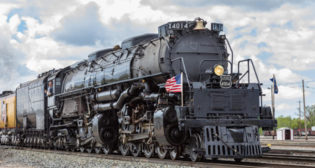
PDI provides technical tour for ASLRRA meeting delegates
Written by William C. Vantuono, Editor-in-ChiefTwenty-five delegates to the American Short Line and Regional Railroad Association Eastern Region Meeting in Erie, Pa., took advantage of an opportunity spend an afternoon touring the manufacturing facilities of Power Drives, Inc. (PDI), a supplier of diesel locomotive idle reduction technologies.
PDI Vice President of Business Development Peter Daigler began with a background presentation on the company, which was founded in 1946 and began as an industrial distributor in Buffalo, N.Y. PDI began manufacturing in the early 1980s eventually becoming a supplier of engineered systems to industry. Daigler focused on PDI’s engineering capabilities and its prototyping and manufacturing equipment, such as 3D printers. He highlighted PDI’s engineered products for the diesel engine market: compressors, turbos, fuel, and EGR water inlet lines.
 Erie Plant Manager Ryan Ray conducted a manufacturing plant tour, which included PDI’s engineered systems for the locomotive industry: oil filter housings, fuel filter and water separation systems, shutter assemblies for air flow control, natural gas filter housings, and hose and tube assembly systems. Ray presented the process by which these systems are manufactured, including the HD plasma cutter and press brake for metal forming. He also explained the process of robotic welding for high volume product welds, the paint booth for OEM customers who require specific product colors, and PDI’s value-add capabilities, such as the engineered PLC-controlled internal cleaning system and heat-sealed caps with special packaging to meet customer-critical cleaning requirements.
Erie Plant Manager Ryan Ray conducted a manufacturing plant tour, which included PDI’s engineered systems for the locomotive industry: oil filter housings, fuel filter and water separation systems, shutter assemblies for air flow control, natural gas filter housings, and hose and tube assembly systems. Ray presented the process by which these systems are manufactured, including the HD plasma cutter and press brake for metal forming. He also explained the process of robotic welding for high volume product welds, the paint booth for OEM customers who require specific product colors, and PDI’s value-add capabilities, such as the engineered PLC-controlled internal cleaning system and heat-sealed caps with special packaging to meet customer-critical cleaning requirements.
Engineering Manager Kevin O’Neal explained the development and manufacturing process fpr PDI’s patented PowerHouse idle reduction systems, which are produced in both an APU (Auxiliary Power Unit) version and a 120-volt plug-in version. “Both systems are the most compact in the industry and are Tier 4 compliant,” he noted. “The 120-volt unit draws only 5 amps of power. The APU version, for locomotives that do not have shore power, trickle-charges the locomotive batteries. Both models are available with remote monitoring to access real-time performance data. Modular design allows for flexibility with installation.” In highlighting the PowerHouse’s benefits, which include “easier start-ups in cold weather, reduced engine wear, no freeze-ups, and no downtime for repairs on engine and cooling system damage due to freezing,” he pointed out that idling “adds maintenance costs of upwards $1 per hour of idling.”



